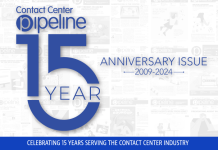
It has been months since the COVID-19 crisis suddenly shifted entire frontline teams home to work. Customer service operations in the hardest-hit industries are still struggling to perform at the most basic level. Customers have taken to social media and have even reached out to the media to share accounts of their time-consuming efforts spent navigating convoluted service mazes, often without finding a resolution or receiving any type of response or acknowledgment from the company.
The pandemic’s disruption of service operations has been an unprecedented source of friction for customers and employees alike. The most common pain points for customers can be grouped into the same frequently reported pet peeves that caused pre-COVID service friction—all of which contribute to lost time.
It’s no secret that customers hate it when companies waste their time. A survey released last fall by visual customer assistance provider TechSee found that certain industries were already suffering from significant levels of customer churn triggered by high-effort interactions. The most cited reasons for high customer effort were:
- Having to call multiple times to resolve the issue, 47%
- Having to repeat their issue more than once, 39%
- Poorly trained or unknowledgeable customer service staff, 32%
- Long wait time to reach a customer service rep, 27%
Sound familiar? These common sources of friction for customers, when added to pandemic-induced stress, anxiety and high emotions, can intensify customers’ frustration. The impact: customer attrition at a time when businesses need to maintain loyalty.
Wasted time, high stress and frustration are not limited to customers. The shift to work-from-home has helped to reduce friction in some parts of agents’ lives, such as alleviating fears regarding personal safety, providing more schedule flexibility and eliminating long commute times, but other sources of friction have surfaced. Home-agents often must work through technical problems or team communication hiccups on their own. Many lack a private workspace in the home or are struggling to juggle work with childcare or eldercare, or both.
Frontline customer service reps also are faced with the pressure of managing callers’ emotions and aggravation with slow processes or confusing policies. Thus, customer friction becomes employee friction, which ultimately turns into company friction when agents burn out or leave.
A Few Considerations for Smoothing the Path
We now understand that the coronavirus will be sticking around for a while. Medical experts estimate that a return to normal isn’t likely to happen until November 2021. What was initially viewed as a temporary disruption to customer service operations now requires contact centers to make more lasting adjustments to work-at-home and on-premise practices and policies.
The next step is to transition from crisis management to redesigning customer service processes to minimize the pain points for both customers and employees. The following are a few key considerations for smoothing the path as you move forward.
Manage Customers’ Expectations
A large part of the aggravation customers are feeling right now stems from a lack of information. Many brand websites are still displaying outdated operating hours, available channels and customer service policies.
The erosion of trust begins once customers discover that the information posted on the website is unreliable. Transparency is critical now and in the journey ahead. Let customers know the what and why of the changes you’ve made, how they can connect and when. Customers are more understanding if they can get upfront information on what to expect, instead of feeling constantly blindsided by service options that come to a dead-end after they’ve invested their time. For example, if you’re not able to provide live-agent support for a time, don’t make customers find this out after calling your 800 number and having to navigate through a complex IVR menu. Or, if your company is not providing refunds for cancellations, make sure that customers are fully aware of the policy before they make the purchase.
Provide as much visibility as possible into call wait times, response times and next steps. Ten minutes in a queue can feel like a lifetime if you don’t know when (or if) you might be connected to the next available agent.
Are customer service contact options all listed on one page or do customers have to hunt through your website to find them? Make sure that there is clear and visible messaging on the company website about available channels, whether they’re staffed and when, hours of operation for each, and response times. Other helpful details for customers:
- Which channel is the best option for reaching a human agent?
- Which types of transactions can be handled on which channels?
- Which channel offers the quickest resolution for basic transactions?
- How long is the average wait time for each?
- How do customers access the available channels?
Communicate as much information as possible, frequently, and do so in different formats and in different places to make it easier for customers to find.
Watch for New Friction Points
As with the employee shift from on-premise to work-from-home models, be aware that removing friction in some areas may introduce friction points in other activities. Customer and agent feedback can help you to identify some of these problem areas.
Analytics offers a more real-time approach. As CallMiner CTO and Founder Jeff Gallino points out in our August 2020 feature, “How to Apply Predictive Analytics to Post-COVID Recovery,” analytics tools can help to identify customer pain points and opportunities for process improvements. “Emotional and sentiment analysis derived from analytics can reveal the types of questions your customers are asking, the topics they care about, and what they want from your brand,” he explains. “This intel can uncover the unknown, identify root problems and guide the entire enterprise. In uncovering insight more rapidly, organizations can make better, more informed decisions on staffing needs, product deficiencies, messaging shifts and more.”
Time for a Leadership Mindset Change
Change can be challenging to manage under normal circumstances, but over the past few months, customers and employees have experienced considerable and abrupt changes to both their work and personal lives—with more to come. What impact has this volatility had on your company culture?
Leading a fully home-based or a hybrid (i.e., a mix of remote and on-site staff) workforce calls for new processes and skills, especially if you’re overseeing a newly remote team—in other words, you need to put on your own oxygen mask first. Leadership training in remote management skills is critical to help you help your work-at-home staff adapt and succeed.
None of this can happen in a silo. Contact center leaders have the data and expertise to advocate internally to reduce friction for customers and employees. A lot can be accomplished by sharing information and new best practices across functions and with the C-suite.
During this pandemic era, change has become transformational, accelerated—and constant. Keeping work-at-home teams engaged and updated on evolving processes requires frequent—daily—connection. Communication that is two-way between supervisors and agents will help to surface challenges and opportunities as they arise.
Some Stickiness Is Good: Being Proactive Builds Loyalty
The effective use of self-service options can contribute considerably to frictionless service delivery. Certainly, customers appreciate a quick, effortless experience when conducting basic transactions. But removing friction from service delivery doesn’t mean making it so that customers never see the human side of your brand. In certain circumstances, some amount of “stickiness” is good, for example, when providing the empathetic human touch that customers need especially now, and which they’re likely to remember long after the world emerges from the pandemic.
Another example of introducing the right type of friction is when taking a more proactive approach to customer loyalty.
Recent research by Gartner (“Driving Customer Retention and Loyalty Through Service”) shows that, when trying to resolve an issue, customers that have a low-effort service experience are 61% more likely to stay with the company—vs. 37% of those who experience high-effort customer service.
But what about the other 39% of customers who had a low-effort experience but will still leave the company? The study’s authors found that customer service organizations can greatly increase customer loyalty by focusing on “value-enhancement” activities that leave a customer feeling like they can use the product or service better and are more confident in their purchase decision. Examples of value-enhancement activities include:
- Educating customers on better uses;
- Advising customers on new uses;
- Validating customer purchase decisions;
- Helping customer achieve a goal; and
- Anticipating customer needs.
Gartner’s research found that customers who receive value enhancement during a service interaction have an 82% probability of staying with the company, an 86% probability of increasing their wallet share, and a 97% probability of spreading positive word of mouth.
As Brent Adamson, distinguished vice president for the Gartner Customer Service & Support practice, explains, “Most often, companies find ‘value-enhancement’ activities fall under the customer success team. Customer service can leverage these same types of activities in the service experience to help drive up customer loyalty.”
Importantly, increasing customer retention, loyalty and wallet share also enhances the value of customer service within the organization, which has been a long-standing objective for contact center leaders.



